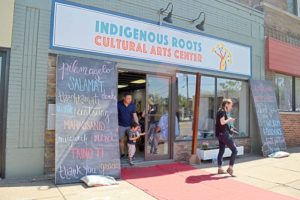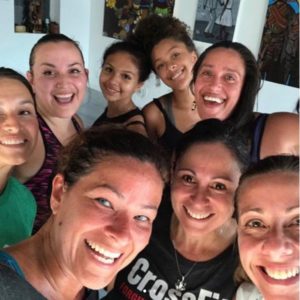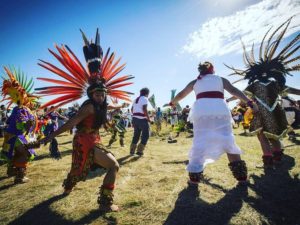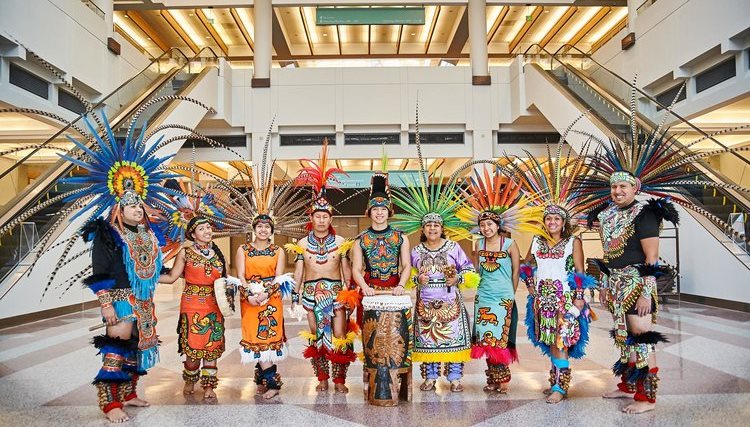In these times of White House-led increasing social and ethnic friction and anti-immigrant fervor in the United States—and a growing resistance by spiritually-healthy, socially-conscious citizens—one might wonder what would happen if a city were to incorporate the celebration and enhancement of cultural heritage and ethnic diversity into its long-term urban planning.
Might that revitalize the city’s social resilience, and help restore a true sense of community? We’re about to find out.
 In the Dayton’s Bluff neighborhood on the east side of the Mississippi River, in the southeast part of Saint Paul, Minnesota, you’ll find the Indigenous Roots Cultural Arts Center.
In the Dayton’s Bluff neighborhood on the east side of the Mississippi River, in the southeast part of Saint Paul, Minnesota, you’ll find the Indigenous Roots Cultural Arts Center.
It’s a collective of cultural community groups, artists and arts organizations dedicated to building, supporting and cultivating opportunities for Indigenous peoples and communities of color through cultural arts and activism. This community based multidisciplinary, multigenerational, multicultural center for Native-Indigenous/POC communities in Saint Paul. It uniquely presents the many faces and creative expressions blossoming in the cultural scene of Dayton’s Bluff. The center applies the model of the East Side Enterprise Center, also created by the Dayton’s Bluff Community Council (DBCC).
Now, in June of 2017, the National Endowment for the Arts’ (NEA) Our Town award of $100,000 has been granted to support the Indigenous Roots Cultural Arts Center and WEQY East Side Radio (also a program of the DBCC) to create an arts and cultural addendum to the comprehensive plan for the city of Saint Paul. The work will be accomplished through a network of partner artists, residents and organizations living and working in Dayton’s Bluff.
 East Side Community Radio (WEQY 104.7 LPFM) is helping to revitalize the East Side as a socially, economically and politically powerful neighborhood by capitalizing on its rich immigrant history and diverse communities. WEQY grew out of the DBCC’s long history of creative engagement and an emerging desire of the East Sides teens and young adults for a creative platform that combines music, conversation, community action, and scene-making events.
East Side Community Radio (WEQY 104.7 LPFM) is helping to revitalize the East Side as a socially, economically and politically powerful neighborhood by capitalizing on its rich immigrant history and diverse communities. WEQY grew out of the DBCC’s long history of creative engagement and an emerging desire of the East Sides teens and young adults for a creative platform that combines music, conversation, community action, and scene-making events.
The Lower East Side neighborhoods of Dayton’s Bluff, Railroad-Island, and Payne-Phalen have maintained a strong, working family identity. Over the past 30 years, the Lower East Side has seen a dramatic demographic shift to become one of Saint Paul’s most diverse areas.
City approved neighborhood plans currently in place are comprehensive in housing, business development, new construction, preservation, greening, corridors, nodes and social vitality, but do not specifically name an arts & culture strategy. This Our Town Cultural Planning project will harness current momentum to add a strong Art and Cultural Strategy to existing plans and build a new unifying theme to connect and amplify the important work of cultural communities through the arts.
 Dayton’s Bluff Community Council mission is “to advance equity and enhance quality of life through partnerships and community engagement.” It strives to connect local residents to their community at large; to their neighbors, parks, restaurants, organizations, councils, businesses, schools, everything their historic neighborhood has to offer. The encourage visitors and residents to stroll along East 7th Street and experience the town’s amazing variety of restaurants, services, beautiful old buildings, new redevelopment, schools, emerging creative spaces and parks.
Dayton’s Bluff Community Council mission is “to advance equity and enhance quality of life through partnerships and community engagement.” It strives to connect local residents to their community at large; to their neighbors, parks, restaurants, organizations, councils, businesses, schools, everything their historic neighborhood has to offer. The encourage visitors and residents to stroll along East 7th Street and experience the town’s amazing variety of restaurants, services, beautiful old buildings, new redevelopment, schools, emerging creative spaces and parks.
In 2017 the Dayton’s Bluff Community Council hired Mary Anne Quiroz, co-founder of the Mexica-Nahua cultural dance group Kalpulli Yaocenoxtli, to serve as its new cultural arts director. AA few months later in May, Quiroz, along with her husband Sergio and a collective of artists, opened the Indigenous Roots Cultural Arts Center next door to WEQY Radio.
“We are doing the work we always love and are passionate about doing,” Quiroz says, “and so for an entity like the National Endowments for the Arts to recognize that — we don’t need them to recognize it — but it sure does feel good. And $100,000 is not so bad either.”
The source of those funds, the NEA was established by Congress in 1965. It’s the independent federal agency whose funding and support gives Americans the opportunity to participate in the arts, exercise their imaginations, and develop their creative capacities. Through partnerships with state arts agencies, local leaders, other federal agencies, and the philanthropic sector, the NEA supports arts learning, affirms and celebrates America’s rich and diverse cultural heritage, and extends its work to promote equal access to the arts in every community across America.
“We want to see this neighborhood grow,” Sergio said, “we want to see the whole East Side be the talk of the city, of Minnesota, and why not the nation? But we can only accomplish that by staying united as artists, united as people, united as organizations to be able to uplift this neighborhood so that we can be top of the nation and be an example for others. Imagine all the things we did being broke. Imagine, with a few dollars, what we can do.”
All photos courtesy of Indigenous Roots Cultural Arts Center.
See East Side News article my Marjorie Otto.
See Dayton’s Bluff Community Council website.

